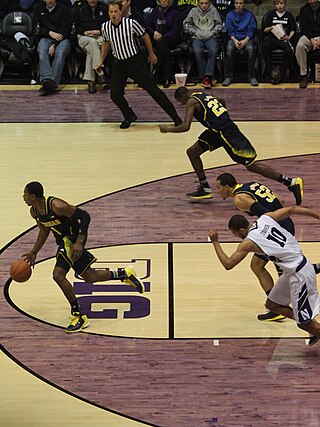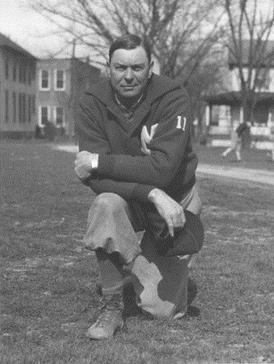
Defence or defense in ice hockey is a player position that is primarily responsible for preventing the opposing team from scoring. They are often referred to as defencemen, D, D-men or blueliners. They were once called cover-point.

In basketball, there are five players that play per team, each assigned to positions. Historically, these players have been assigned to positions defined by the role they play on the court, from a strategic point of view. The three main positions are guard, forward, and center, with the standard team featuring two guards, two forwards, and a center. Over time, as more specialized roles developed, each of the guards and forwards came to be differentiated, and today each of the five positions is known by a unique name and number: point guard (PG) or 1, the shooting guard (SG) or 2, the small forward (SF) or 3, the power forward (PF) or 4, and the center (C) or 5.
Zone defense is a type of defense, used in team sports, which is the alternative to man-to-man defense; instead of each player guarding a corresponding player on the other team, each defensive player is given an area to cover.
Man-to-man defense, or man defense, is a type of defensive technique used in team sports such as American football, association football, basketball, and netball, in which each player is assigned to defend and follow the movements of a single player on offense. Often, a player guards his counterpart, but a player may be assigned to guard a different position. However, the strategy is not rigid, and a player might switch assignment if needed, or leave his own assignment for a moment to double team an offensive player. The term is commonly used in both men's and women's sports. The alternative to man-to-man defense is zone defense, a system of defense in which each player guards an assigned area rather than a specified opponent.
Basketball moves are generally individual actions used by players in basketball to pass by defenders to gain access to the basket or to get a clean pass to a teammate to score.

Fast break is an offensive strategy in basketball and handball. In a fast break, a team attempts to move the ball up court and into scoring position as quickly as possible, so that the defense is outnumbered and does not have time to set up. The various styles of the fast break–derivative of the original created by Frank Keaney–are seen as the best method of providing action and quick scores. A fast break may result from cherry picking.

This glossary of basketball terms is a list of definitions of terms used in the game of basketball. Like any other major sport, basketball features its own extensive vocabulary of unique words and phrases used by players, coaches, sports journalists, commentators, and fans.

The Tampa 2 is an American football defensive scheme popularized by the Tampa Bay Buccaneers National Football League (NFL) team in the mid-1990s–early 2000s. The Tampa 2 is typically employed out of a 4–3 defensive alignment, which consists of four linemen, three linebackers, two cornerbacks, and two safeties. The defense is similar to a Cover 2 defense, except the middle linebacker drops into a deep middle coverage for a Cover 3 when he reads a pass play.
A full-court press is a basketball term for a defensive style in which the defense applies pressure to the offensive team the entire length of the court before and after the inbound pass. Pressure may be applied man-to-man, or via a zone press using a zone defense. Some presses attempt to deny the initial inbounds pass and trap ball handlers either in the backcourt or at midcourt.

In American football, the specific role that a player takes on the field is referred to as their "position". Under the modern rules of American football, both teams are allowed 11 players on the field at one time and have "unlimited free substitutions", meaning that they may change any number of players during any "dead ball" situation. This has resulted in the development of three task-specific "platoons" of players within any single team: the offense, the defense, and the so-called 'special teams'. Within these three separate "platoons", various positions exist depending on the jobs that the players are doing.
The following terms are used in water polo. Rules below reflect the latest FINA Water Polo Rules.
The dribble drive motion is an offensive strategy in basketball, developed by former Pepperdine head coach Vance Walberg during his time as a California high school coach and at Fresno City College.
The game of lacrosse is played using a combination of offensive and defensive strategies. Offensively, the objective of the game is to score by shooting the ball into an opponent's goal, using the lacrosse stick to catch, carry, and pass the ball. Defensively, the objective is to keep the opposing team from scoring and to dispossess them of the ball through the use of stick checking and body contact or positioning.

Eli Camden Henderson was an American football, basketball, and baseball coach and college athletics administrator. He served as the head football coach at Muskingum College (1920–1922), Davis & Elkins College (1923–1934), and Marshall University (1935–1949), compiling a career college football record of 161–91–13. Henderson was also the head basketball coach at Muskingum (1920–1923), Davis & Elkins (1923–1935), and Marshall (1935–1955), tallying a career college basketball mark of 621–234. As a coach in basketball, he originated the fast break and the 2–3 zone defense, hallmarks of the modern game.

The 1–3–1 defense and offense is a popular strategy used in basketball.

The 2–3 zone defense is a defensive strategy used in basketball as an alternative to man-to-man defense. It is referred to as the 2–3 because of its formation on the court, which consists of two players at the front of the defense and three players behind.
The amoeba defense is a defensive strategy in the game of basketball.
Basketball is a ball game and team sport in which two teams of five players try to score points by throwing or "shooting" a ball through the top of a basketball hoop while following a set of rules. Since being developed by James Naismith as a non-contact game that almost anyone can play, basketball has undergone many different rule variations, eventually evolving into the NBA-style game known today. Basketball is one of the most popular and widely viewed sports in the world.
Cherry picking, in basketball and certain other sports, refers to play where one player does not play defense with the rest of the team, but rather remains near half court or closer to their own team's goal.
Wheel offense is an offensive strategy in basketball, developed in the late 1950s by Garland F. Pinholster at the Oglethorpe University. It is a kind of continuity offense in which players move around in a circular pattern to create good scoring opportunities. The wheel offense is a popular offensive play, frequently used by teams from middle school to college levels because it can effectively work against any defense, including zone defense and man-to-man defense.









